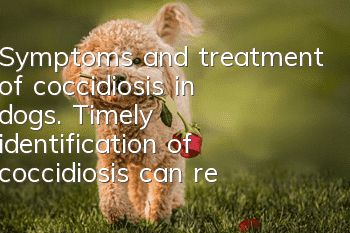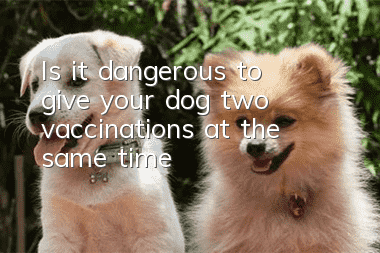Symptoms and treatment of coccidiosis in dogs. Timely identification of coccidiosis can restore your dog’s health.

Table of contents
What is coccidia?
⊙Symptoms of coccidiosis in dogs
⊙The danger level of coccidia to puppies
⊙Drug to prevent/treat coccidia
⊙Things to note during the treatment of coccidia
New dog owners are most afraid of their dogs getting sick, especially diarrhea. Once you encounter a puppy with diarrhea and blood, do you feel as if the whole world is falling and you are scared? Because when veterans encounter rare blood, they will always first say that it may be small.
However, after reading this article, you will know that loose and bloody diarrhea does not necessarily mean it is small. An infection with coccidia, a parasitic worm, can also cause similar symptoms.
What is coccidia?
Coccidia is a spore-like parasite that lives in the epithelial mucosal cells of the small intestine. Both large and small dogs can be infected, but due to their good physique and strong resistance, large dogs usually do not have many symptoms of infection, while puppies between 1 and 6 months old are prone to obvious symptoms of gastrointestinal infection.
Symptoms of coccidia in dogs
As mentioned before, many novices will misunderstand the symptoms of coccidia as trivial, which shows the similarity of the symptoms.
Similar to Xiaoxiao:
① Both have bleeding symptoms
② All have diarrhea symptoms
③ All have symptoms of enteritis
Specific ways to distinguish:
① Small bleeding usually occurs in the middle and late stages of the attack, that is, the bleeding starts after a period of diarrhea, while coccidial bleeding appears earlier; small bleeding is usually mixed with "thin" and surrounding fluid, while coccidia usually shows a few drops of blood at the end of defecation;
② Small is generally a viral enteritis. The later stage of coccidia can lead to hemorrhagic enteritis. Coccidia acts on the small intestine, causing the gastrointestinal mucosa to fall off, so you can see jelly-like clumps of mucosa, accompanied by blood. In this case, the probability of coccidia is extremely high;
③ Small ones mean diarrhea and vomiting, while coccidia usually means loose stools~
Summary of coccidia symptoms:
In the early stage, loose stools, jelly (mucous membrane) stained with blood, mild fever, and lack of energy; in the later stage, diarrhea with a bloody sample... This is generally very late, Therefore, symptoms must be treated promptly, otherwise the life of the puppy will be in danger.
How dangerous coccidia is to puppies
The following photos are a bit harsh
Eating snacks during meals
Don’t look at it yet
Continue reading after eating
Otherwise I will lose my appetite...
The photos are on the Internet to show you the horror of coccidiosis and blood in the stool in the later stage. At this level, it is really difficult to treat, so early detection and early quality are necessary.
However, generally dogs do not get coccidiosis to such a serious extent. Such serious cases often occur in puppies, elderly dogs, or other diseases, or in dogs that are recovering from other serious illnesses. In these special circumstances , the dog’s immunity is much weaker, which will give coccidia an opportunity to wreak havoc on the intestines, eventually leading to irreversible consequences.
So if you find that there is blood in the stool with mucous membranes in the early stage, you should send it to the hospital for a stool examination as soon as possible. Fecal examination is very simple and can be done in 20 or 30 years. Find a hospital with a microscope.
Medicine to prevent/treat coccidia
The drug that is generally used for dogs and is more effective is Happy Brown Sugar produced in Taiwan. The ingredients of this drug are a lot of English abbreviations, so Ping An’s mom doesn’t know the specific ingredients, but it just works well.
The key is, don’t buy fakes. There are still many fakes of this medicine.
By the way, the preventive dosage and the therapeutic dosage are different. If you have been diagnosed with coccidia, or there are early symptoms of bloody mucous membranes, use the therapeutic dosage.
This kind of drug treatment can only be used for the early stage. If it is serious, you must go to the hospital. Not only these drugs are used, but also hemostatic drugs, anti-inflammatory drugs, etc. are used. Don't be careless.
Another type of antibiotic that is effective against coccidia is sulfa antibiotics, such as cotrimoxazole. Quite simply, coccidia are afraid of sulfonamides. But this Ping An mother thinks that preventive use is okay. Symptoms have already appeared. The effect of sulfonamide is a bit slow. I am afraid that it will be delayed until it is serious. It is best to buy special coccidiosis medicine for dogs.
As for the treatment mentioned above, here is how to prevent it:
Puppies, every puppy should be dewormed once within three months, regardless of whether there are related symptoms or not. Symptoms, this can help puppies safely pass the critical age of three months, and the probability of serious problems after three months is low.
To prevent cross-infection, don’t let your dog develop the habit of eating outside food.
Things to note during the treatment of coccidia
Coccidia can easily develop drug resistance, so for treatment or prevention, you can consider rotating the use of different drugs next time. Fortunately, this kind of drug resistance will disappear as long as you stop taking the medicine for a few months, so don't worry too much.
Vitamin B is a vitamin that helps the growth of coccidia, so when symptoms of coccidia appear, stop taking VB drugs or foods rich in VB.
Vitamin A and vitamin K are vitamins that help inhibit coccidia. During the treatment of coccidia, they can be taken in appropriately to assist in the treatment.
- What to do if Schnauzer has yellow hair on his mouth
- What causes dogs to bite their tails?
- How long do dogs sleep at night?
- How long does it take for a dog to shed its hair?
- Dosage of montmorillonite powder for dogs
- Dog poop has white bugs
- What to do if the dog refuses to obey?
- Why is the dog panting rapidly?
- Can dogs eat five-nut mooncakes?
- Why can dogs understand human speech?



